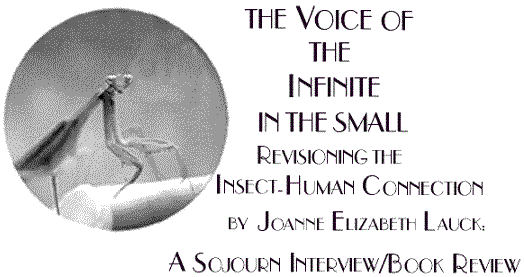The
assumption that insects are our adversaries comes from an approach
to nature based on power and dominance, and has led our culture to wage
a relentless war against them. When we see insects eating hybrid crops,
we destroy them. When we see them on garden plants, we assume they will
overrun the plants. Even organic gardening is not necessarily insect-friendly.
The natural influx of insects in the spring
can be understood and trusted as an aspect of their intimate and reciprocal
relationship with plants. When a plant is sick or lacks vitality,
it calls the insects (through scent molecules) to come in and destroy it.
Insects are messengers. If they are present in large numbers, or if an
individual insect is behaving unusually, we might ask, "What is its/their
message?" "Is the human community out of balance?" "Are our
food plants and soils healthy?" Likewise, when they appear in our dreams,
we might ask, "What in our psyche needs to be restructured?"
When I started this book, all I knew was that
our unjust treatment of insects indicated a cultural blind spot. What I
didn't know was that insects have an intimate connection with the universal
renewal process in the human psyche, as well as in nature. As initiators,
they arouse us and show us shadow material. They also bring us grace and
blessings.
This information has come to me over a period
of seven years. When we set aside prejudices and fears and begin to open
to the beauty, drama, and transformative power of the insect kingdom--even
those of the various pest species--our lives will change. We will be reunited
with a part of our community from which we have been profoundly alienated,
and all manner of unexpected benefit will follow.
The Voice of the Infinite in the Small
weaves together stories, scientific data, anecdotes, dreams and myths.
It draws from people of indigenous cultures such as teacher and author
Brooke Medicine Eagle, and from scientists such as entomologist Edward
O. Wilson.
The book discusses specific pest species and
poisonous insects in individual chapters, attempting to show the
reader portraits that are different from the official views we have learned.
Take the housefly that throws up on its food or on our skin to digest its
food. We despise them for their association with death and decay, yet these
master recyclers are second only to bees in importance to life on Earth.
Their disease-causing reputation is largely overrated. With proper hygiene,
the bacteria on a fly is unlikely to cause us a problem. We are uncomfortable
with the decay of our own body, uncomfortable with our body processes and
fluids. Life secretes things. If we choose to focus on the fluids of certain
species only (consider that the honey we savor is made up of bees' vomit)
and then move to selectively kill them, what does that say about us? Remember
we are also covered with bacteria, and we exchange saliva and bacteria
when we share a drink with someone or kiss them.
Each species has lessons for the willing
human. The scorpion is considered a guardian of the gates to higher awareness,
protecting those who are psychologically unready. They act to arouse us,
helping us move toward greater fulfillment, or to show us what we don't
want to see but need to see in order to grow. Ants adjust the density of
their colony so that they always live at the edge of chaos. This has implications
for us. So does the fact that one-fourth of home pesticide use is directed
at insects that neither bite, sting nor transmit diseases.
the book includes a chapter on mosquitoes. What does it mean
to share your blood? What is another way to think about being bitten or
stung by insects? To the native people this was a signal to see whether
you are doing something out of balance, or whether the imbalance is in
the larger environment. When an insect "calls you" to work with it, you
become its student. In shamanic journeys, information is often transmitted
through vital fluids, the bite or the sting. The animal marks you to benefit
from its medicine.
I began writing an animal book, intending
to include a chapter on insects, but they obviously had other ideas! As
I look back, one of my fondest memories is the wagon of dirt and worms
I tended at age four. The first dream I ever recorded was an insect dream,
and my first spontaneous interspecies communication was with insects. This
has made me think, "Wait a minute. I've been set up!"
This book goes beyond asking people to examine
their fear and mistrust of insects and to free themselves from the trap
of thinking we either have to kill or be defeated by them. Through stories
and examples of people who have done so, I propose the possibility of communicating
with insects. Endorsed by deep ecologists, ecopsychologists, animal lovers,
environmentalists, and people in spiritual traditions who practice harmlessness,
I see my work as an invitation to draw our circle of community big enough
to encompass all life-forms--regardless of size, appearance or behavior.
They are all our relations, and all worthy of our respect, admiration and
affection.

Joanne Lauck is an environmental educator, graphic designer and
wildlife rehabilitator. She teaches an elective course for children called
"Thinking Like a Bug." Joanne welcomes insect stories and dreams
for possible use in a second book. She can be contacted at 1724 Alberta
Avenue, San Jose, CA 95125 or via email at jleafhobbs@aol.com . The
Voice of the Infinite in the Small is published by Swan *
Raven & Co, 1998, and is available in paperback.
Ain't
I A Woman? ~ Cover Artist: Joanie Mitchell
Dreamstream ~From the Publishers ~ Public
Service
Voice of the Infinite in the
Small ~ Welfare Reform
Wild2K ~ Y2K
Citizen's Action Guide
Y2K Task Forces in Rural
Northern California
All Rights Reserved. Copyright © 1999 Sojourn Magazine
